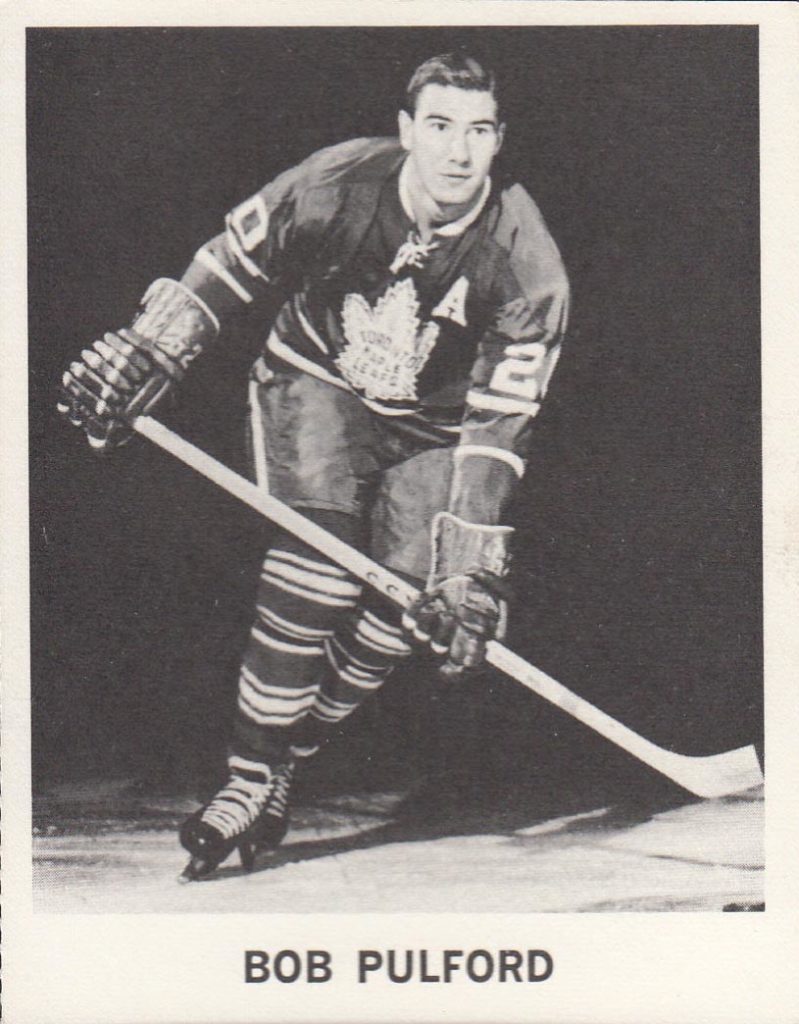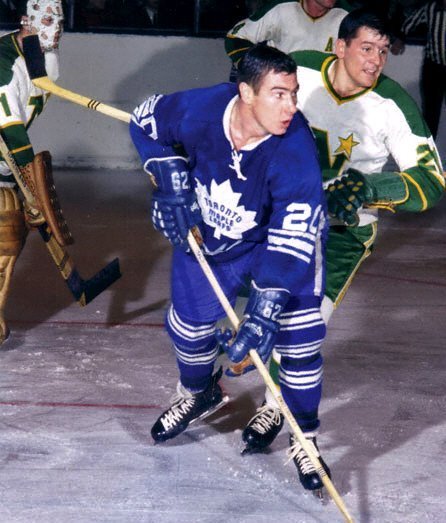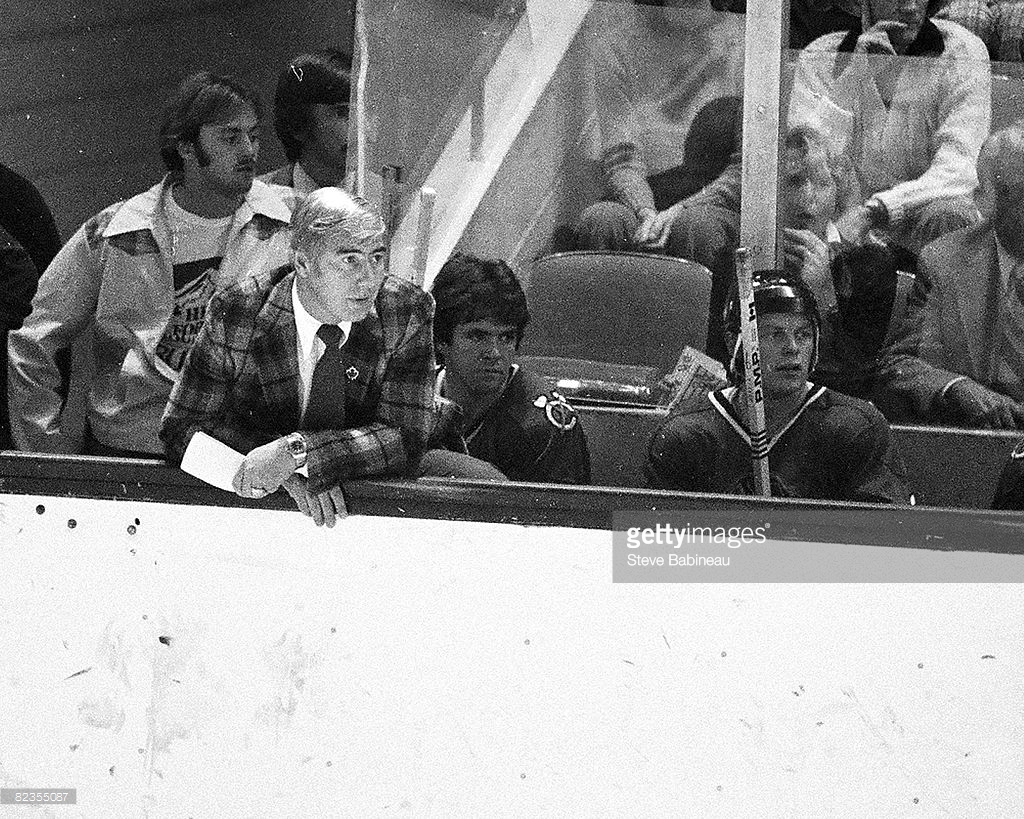Michael Langlois of Vintage Leaf Memories will stop by Maple Leafs Hot Stove throughout the Maple Leafs’ centennial season to provide his reflections on past Leaf teams and players from his sixty-plus years of following the Blue and White.
The Maple Leafs have never honoured the old number 20 of longtime forward Bobby Pulford, but he is certainly worthy of that kind of consideration.
I was born in the early 1950s, so I was quite young during the early part of “Pully’s” career in blue and white—he played his first NHL season in 1956-‘57. But raised in a passionate Hab-loving family (I rebelled early), I was already well into following and watching the Leafs by the late 1950s. And that’s when Pulford was coming into his own as an outstanding all-around NHLer.
Over the years there has been a lot of debate around the notion that getting into the NHL Hall of Fame is not as difficult as it is in other sports, and I would tend to agree. In fact, “The Rocket” himself (Maurice Richard) made that claim in a magazine article I read as a kid in the early 1960s, a few years after Rocket had retired. And one of the names that is tossed around on occasion that supposedly doesn’t belong in the Hall is Pulford’s.
I see things differently.
I don’t think being a great player is necessarily about goals and points, though that certainly can be a factor, of course. Pulford could put the puck in the net, yes, but he brought more to the table than that.

Pulford, for his era, had good size (around 190 pounds) but nothing out of the ordinary. He was not Gordie Howe or “Moose” Vasko, who were considered some of the biggest guys in the league at the time. Pulford was a classic blue and white Leaf grinder, and I would have to believe his approach to the game was much appreciated by the founder and owner of the Leaf franchise, Conn Smythe.
Pulford came out of the Toronto Marlborough junior system that produced so many of the Leafs I grew up admiring in the 1960s. He arrived on the scene just a bit before Frank Mahovlich (“The Big M”) did. He wasn’t tall and rangy like Frank, and did not have Mahovlich’s flash or big shot. But I liked Pulford for a simple reason: when he hit you, you felt it. Before longtime analyst (and another former Leaf) Howie Meeker used to talk routinely on television in the 1970s about “finishing your check”, that’s what Pulford did.
He must have been awfully tough to play against. There was not a lot that was flashy about number 20. He seemed just as happy to hit a guy as he did scoring a goal. And he often finished his check by running right through the opposing forward or defenseman. That kind of toughness is a trait some Leaf teams have been without over the years (though Gary Roberts did my Leaf heart good during his brief stopover in Toronto in the early 2000s, as did Wendel Clark before him and Brian Spencer back in the early 1970s).
Believe it or not, Pulford was a “third line” center for the up and coming early ‘60s Leaf team that was being judiciously pieced together by then General Manager and Coach Punch Imlach. In those days, teams really didn’t use a fourth line much, if at all, as I recall. (Billy Harris was the fourth Leaf center back then, a skilled skater and gifted playmaker. But it was hard for him to see much ice time, given smaller rosters and the long shifts guys used to play.)
Pulford played “behind” Red Kelly, who Punch brought over in a trade with the Red Wings during the 1959-’60 season. Imlach converted the Norris Trophy-winning defenseman into a center to help the Leafs take on big Jean Beliveau in Montreal, when the teams used to play 14 times a season—and often in the playoffs as well. Pully also ceded some time to young Dave Keon, who was blossoming into a future Hall-of-Famer himself. (A quick historical note: the vaunted Habs were the only other team who had as good a set of centers as the Leafs, with Beliveau, Henri Richard, Ralph Backstrom and a young Phil Goyette.)
But Pulford wasn’t just a guy who finished checks (and he could fight, too). He scored almost 300 goals throughout his NHL career. He was certainly durable, rarely missing time because of injuries despite his aggressive style of way.
But what I remember most about Pulford offensively is that he scored big goals—goals that mattered.
A few examples come to mind: the Leafs had no business making the playoffs at the end of the 1958-59 NHL season, but they went on a major run and finally overtook the Rangers on the last weekend of the regular season. Then, in the semi-finals against the favoured Bruins in the spring of 1959, the Leafs were trailing (if I remember correctly—it was a long time ago…) heading into the third period of Game 7 in Boston. But a timely Pulford goal helped spur a rally that saw the Leafs come from behind and upset the Bruins.
In April of 1964, the Leafs were hosting the Detroit Red Wings in Game 1 of the best-of-seven Cup final. The game was tied in the dying seconds. The Wings were on a power play. I stand to be corrected, but in those days, Red Wing great coach (and former playing great), Sid Abel, liked to use five forwards at times on the power play, with his go-to guys, Gordie Howe and Alex Delvecchio, on the point.
With only seconds to go, Detroit won the face-off to the right of Johnny Bower. The puck went back to the point but Pulford blocked Delvecchio’s shot, corralled the puck and was off to the races.

Howe was in pursuit from the other side of the ice, but just before Howe went to slash the puck away from Pulford, Pully got a shot off that beat future Leaf Terry Sawchuck. There were maybe two or three seconds left on the clock. I was watching on our old black and white television, all of 10 years of age, and I was briefly in hockey heaven—as were lots of other kids and Leaf supporters at the time. It’s one of those plays you always remember.
The Leafs went on to win the Cup in 7 games. It was a series that could have gone either way—despite what seemed to be a lopsided 4-0 Game 7 in Toronto. (It wasn’t—the Wings hit the post at least once when it was still just 1-0 in the second period, which could have turned the game around. Detroit also might well have won Game 6 at the old Olympia in Detroit; they had the lead, only to lose in overtime on Bobby Baun’s famous “broken ankle” winner.)
Fast forward to 1967: the Leafs had no business making it to the finals after what had been a tumultuous season. (Both Mahovlich and Imlach had been hospitalized at different points during the season.) That was also the year the Leafs struggled through a 10-game winless streak, and Assistant GM “King” Clancy took over for Imlach behind the bench while Imlach was ill.
But the Leafs still managed to make the playoffs in that last season before expansion. They somehow came together to upset the first-place Chicago Blackhawks in a six-game semi-final series. One of the key reasons was the line that was put together during Imlach’s convalescence by interim coach King Clancy—Pulford shifted from center to the wing, while Pete Stemkowski was the pivot on a line that also featured an emerging sniper in Jimmy Pappin. (I believe it was Clancy, not Imlach who pulled that line together. But others who were also around at the time may remember things differently.)
That trio was huge against the Hawks, and also played very well against the heavily favoured and speedy Habs in the finals as well.
In fact, in Game 3 of the finals at the Gardens, a tense contest went into double-overtime, before Pulford re-directed a pass behind Rogie Vachon in the Montreal net to give the Leafs a two-to-one game lead in the series.
The Leafs got hammered in Game 4 at home, as Johnny Bower did not play again in the series after hurting himself during a brilliant performance in Game 3. (Terry Sawchuck ran with things the rest of the way.) But the Leafs managed to get past Montreal for what has turned out to be their most recent (ugh) Stanley Cup championship.
Pulford stayed with the Leafs for another three seasons, but like a lot of guys who play that hard for that long, I never thought he was quite the same player—at least not consistently. He was still a fine Leaf, but not quite the factor he had been earlier in his career when he was a constant thorn in the side of this opponents. (Of course, the Leafs also were not as good a team in those years as well.)
He played his last two years with the expansion LA Kings in the early 1970s before soon establishing himself as one of the bright, young and highly innovative coaches in the league.
He led the Kings to a great finish during the 1974-’75 season before losing in a best-of-three series to a middling Leaf side in a major shocker at the time (Pulford is the father-in-law of current GM Dean Lombardi of the Los Angeles Kings, who honoured Pulford in 2012).
Pully also had some very good years coaching the Hawks, where he was also a long-time GM and executive until 2007.

But as we celebrate the NHL’s 100th anniversary season and an enlightened approach from current Leaf management when it comes to celebrating “the old days”, Pulford is a guy who brings back wonderful memories of when the Leafs were really, really good. They had skill, for sure (guys like Mahovlich, Harris, Keon, Dickie Duff, Carl Brewer, Tim Horton and later, Mike Walton in that ’67 Cup season) but mostly they played a tough, two-way game under Imlach and relied on Bower. And Pulford was at the top of the list of guys who loved to compete—and win—in a Leaf uniform.
To me, he is a big part of our legacy, and should certainly be honoured for his contributions as a player here.




































